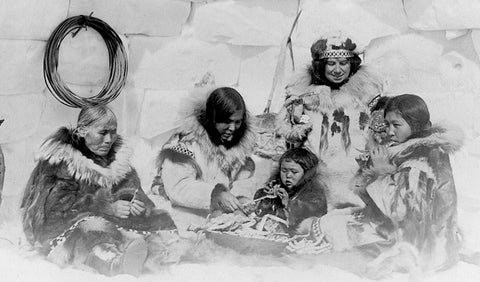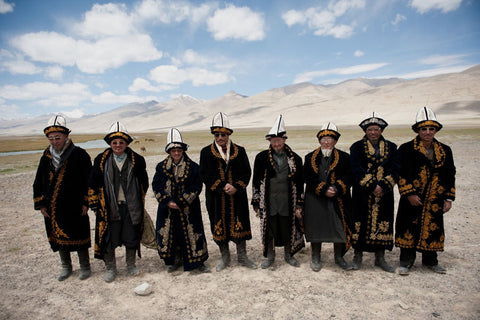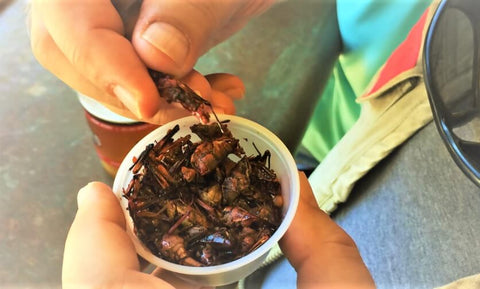Close your eyes and stick a pin on a map of the world.
If you’ve hit a land mass—and, in some cases, even if you haven’t—then chances are that somewhere nearby lives a culture still hunting and gathering as a means of survival.
For these cultures, Paleo, or something bearing a strong resemblance to it, isn’t a lifestyle choice—it’s the only choice. And that hasn’t changed in nearly 3 million years.
Today, what some call the “caveman diet” is still in practice in several regions around the globe, places where the people have evolved from prehistoric trappings and are adapting to a 21st-century existence. Some are thriving, while others are in danger of seeing their society disappear.
Inspired by National Geographic’s excellent “Future of Food” series, let’s take a look at five of these groups – and what lays ahead for them.
+ + +
1. The Hadza

Where They Live
Tanzania.
What They Eat
The thousand remaining Hadza living near Lake Eyasi are full-time hunter-gatherers who eat berries, plants, and game.
Their diet is noted for the levels of beneficial “gut bacteria” it fosters, making it an appealing subject of study for scientists. Some even believe that you can trace a connection from the Hadza to the Cradle of Life itself. And all across that connection, they’ve eaten the same things.
Their Way of Life
“The Hadza do not engage in warfare,” writes Michael Finkel in National Geographic.
“They’ve never lived densely enough to be seriously threatened by an infectious outbreak. They have no known history of famine; rather, there is evidence of people from a farming group coming to live with them during a time of crop failure. The Hadza diet remains even today more stable and varied than that of most of the world’s citizens. They enjoy an extraordinary amount of leisure time. Anthropologists have estimated that they ‘work’—actively pursue food—four to six hours a day. And over all these thousands of years, they’ve left hardly more than a footprint on the land.”
Yet even this model of civilization is under threat from another wave of land grabs in Africa. They’ve been painted into a corner of a reservation one-quarter the size of their original home turf. And now their countrymen in Tanzania, enamored with the advances introduced by the West—as well as Africa’s promising economic future—look upon them with shame.
2. The Inuit

Where They Live
Alaska, Canada, Greenland, Siberia.
What They Eat
Meat, and a lot of it. The percentage of an Inuit’s daily calories dedicated to animal protein and fats, in the form of seals, narwhal, fish, polar bear, walrus, and whale, is often as high as 85%.
You’ll see similar figures in reference to the Evenki and Yakut of Siberia. Some of these groups forage for berries, plants like horseradish and onions, and seaweed, as well.
Their Way of Life
For what was once a healthy culture (albeit one that confounded nutritionists), modern encroachment and migration to places like Denmark has come at a cost.
Cigarettes, booze, and more access to supermarket junk food (chips, enriched flour, vegetable oil) are compromising the Inuit diet and lifespan. Heart and respiratory disease has begun to creep in, and obesity-related conditions are taking off, too.
3. The Kyrgyz Nomads

Where They Live
Afghanistan, China, Pakistan.
What They Eat
For the nomadic Kyrgyz living in the Himalayas—there are just over a thousand in Afghanistan—plant life is scant at best. In turn, they must derive the vast majority of their nutrition from the animals they raise: camels, goats, horses, sheep, and, of course, yak.
The Kyrgyz do eat some dairy and grain, but, like the Inuit, their diet is dominated by meat. At times, they fry the meats in yak butter (which Keto dieters in particular would love), and they consume every edible part of the animals, including the eyes.
Their Way of Life
Although offered asylum in the Kyrgyz Republic, where life expectancy is over 70, the Kyrgyz nomads insist on staying on the move for their existence. They face some political adversity in the way of closed borders, but the peregrinations they do make are based on nutritional needs, as opposed to persecution.
The nomadic Kyrgyz are relegated to terrain so challenging that they have it all to themselves—including plentiful sources of animal protein—but major deficiencies in medical care and a dangerous spread of opium addiction mean most people don’t make it past 40.
4. The Sama-Bajau

Where They Live
Southeast Asia, historically seaborne.
What They Eat
Maritime nomads (known as the “Sea Gypsies”) who often reside in stilted platforms reminiscent of the 1995 Kevin Costner bomb Waterworld, the Sama-Bajau are divers and fishermen who have traditionally gotten everything they need from the sea: fish, octopus, abalone, and vegetables.
Their Way of Life
Today, the Sama-Bajau culture is falling apart, but not due to their diet.
Modern regulations are not particularly nomad-friendly, particularly in the fishing industry, and around the Philippines and Malaysia, many of the group are living in abject poverty. Where once they were able to establish themselves in a market that demanded protein sources like salt fish and dried fish, they’ve now been all but crowded out.
Consequently, they’re gravitating toward agricultural communities and gradually losing their identity. For those who have assimilated, another interesting skill has emerged on land: exceptional horsemanship.
5. The Tsimane

Where They Live
Bolivia.
What They Eat
Although they now farm starchy plantains and manioc with slash-and-burn tactics, the 15,000-strong Tsimane have primarily subsisted on fishing, rainforest plants, and hunting Amazonian game including tapirs, capybaras, monkeys, coatis, and peccaries.
The Tsimane are one of the cultures Paleo advocates point to when discussing health benefits, as they don’t develop heart disease. However, an increasing reliance on markets has led to an uptick in diabetes.
Their Way of Life
Like the Hadza, the Tsimane have seen their food sources dwindle with expanding industry (in this case, logging) and climate changes bringing about more storm patterns.
These factors, combined with the rampant growth of the South American economy and their status as perhaps the most medically studied indigenous people on the planet (yet another thing they have in common with the Hadza), could soon usher in a new era of modernity for the Tsimane—one that may not favor them.
+ + +
While these cultures’ average life expectancies admittedly don’t match those of the United States, their quality of life and avoidance of chronic illness is well worth considering.
As it turns out, the caveman diet was highly evolved.
These diverse, sustainable sources of unprocessed food—full of protein, vitamins, and probiotics—make them worth emulating, but overreaching agribusiness has seen to it that we won’t have much more time to take notes.
+ + +
If unprocessed food full of protein, vitamins, and probiotics sounds good to you, then we’re guessing you’ll want to try some Exo protein bars.









